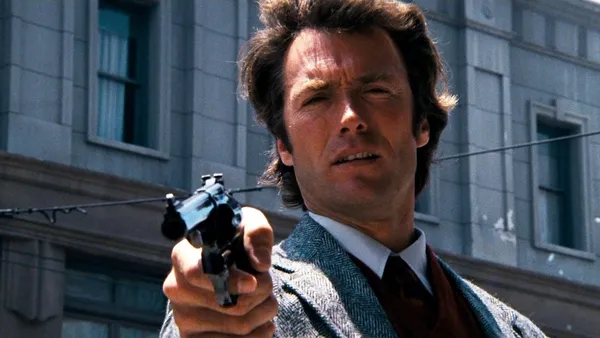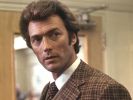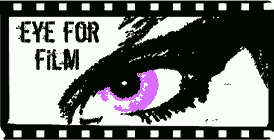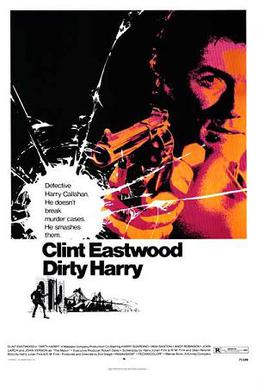Eye For Film >> Movies >> Dirty Harry (1971) Film Review

Above, against an azure sky, the silenced barrel of a sniper rifle points out at you. Almost straight in your face. Behind it, out of focus, the gunman, the serial killer Scorpio (Andy Robinson). It is the serene alcove of the Madonna writ large across the anamorphic. Below a woman swims in a rooftop pool. The music changes from a pulsitive jazz drumbeat to ethereal vocal polyphony. There is a gunshot. Just for a moment the woman is cruciform, dying in the blue pool.
This is the murder that Inspector Harry Callahan (Clint Eastwood) is set to investigate. At the murder scene Harry finds a note from the killer. If he does not receive a hundred thousand dollars he will kill again - a Catholic priest or an African American (here Scorpio uses a racial slur). Before the plot properly kicks off there is a vignette that speaks to Harry's character. After interrupting a bank robbery he ends up pointing his Magnum revolver[1] at one of the injured bank robbers. Standing over the man, Harry delivers a monologue that ends with the iconic line "Do I feel lucky? Well, do you, punk?" The monologue will be repeated at the end of the film.

Harry is paired with a rookie cop, Inspector Chico Gonzalez (Reni Santoni), and the cat and mouse game with Scorpio begins. The loose cannon and college kid isn't the first unconventional partnership in the history of crime fiction, but is the one that sets up the expectation in everything that comes after it. It's the template for the cop on cop antagonism in films like Lethal Weapon and every other detective show on TV.
The filmscape created by Eastwood, the director Don Siegel and Bruce Surtees his director of photography, is that of the panoramic western and the expressionist, the noir like. It stretches out through many of Eastwood's later films. Bruce Surtees, sometimes referred to as The Prince Of Darkness because of his mastery of low light filming, had worked on two of Eastwood's previous films: The Beguiled and Play Misty For Me. He depicts San Francisco as a dirty, seedy city. At night the city's underbelly is full of strip clubs and danger. A contrast of burning neon and crushing blacks. The dream is over; here free love is a commodity.
Religious imagery runs through the film: Saints Peter and Paul Church and the threat to kill a Catholic priest; repeated use of the name Mary and a particular shade of blue; glowing Jesus Saves signs shot up by machine gun fire; the Mount Davidson Cross 30 meters of concrete lit up against the black of night. Harry runs towards it, becoming as small as an insect beneath it.
Harry first confronts Scorpio beneath the cross. Andy Robinson's performance infantilises the killer. His Scorpio has a childlike voice, fast and nervous, trying to explain to an adult that doesn't understand. When things don't go his way he appears to be on the edge of a tantrum. At the end of the film they come face to face again. The gun, the Magnum, and Harry framed against the azure sky. How similar are the adversaries? When it's over Harry throws his badge away. Is it his frustration with a system that hamstrung his attempts to catch Scorpio, or is it disgust at what he has become?
Dirty Harry helps usher in a series of nihilist American thrillers that typified the 1970s, like Dog Day Afternoon, Deliverance, Taxi Driver, Chinatown, The Conversation. The serial killer Scorpio with his peace symbol belt buckle represents a disillusionment with the ideals of 1960s counter culture that had already started to show through in films like Vanishing Point. He is greedy for sensation and childlike entitlement. He is consumption, not the altruistic values that post war American society imagines itself having. The Pentagon Papers have already dropped. Events such as Watergate and defeat in Vietnam will play into American cinema's reappraisal of itself. Is wearing a white hat the only thing that makes America the good guys? Is might right? Does having the most powerful handgun in the world make you an arbiter of justice?
[1] Smith & Wesson Model 29 chambered for .44 Magnum cartridges
Reviewed on: 01 May 2025

















